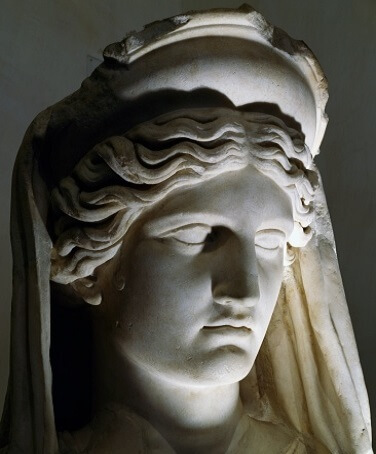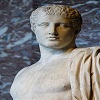Demeter
Goddess of Corn, Grain, and Harvest
One of the oldest Greek gods, Demeter (Roman name: Ceres) guaranteed the fertility of the earth and protected farming and vegetation. This close connection with the earth was inherited from her mother Rhea, and doubtless she was a reincarnation of local mother-Earth goddesses, commonly worshipped in rural communities.
Daughter of Kronos and Rhea, sister of Zeus, Poseidon, Hades, Hera, and Hestia, Demeter was the mother of Persephone and Iacchus (both with Zeus) and Pluto, the god of wealth (with Iasion, who was subsequently killed by a thunderbolt from a jealous Zeus). She also adopted Triptolemus, the Eleusinian prince, who gave the human race the gifts of the plough and knowledge of agriculture. Demeter was also pursued by Poseidon and to escape his attentions, she changed into a mare; however, Poseidon too changed into a horse and their resulting offspring was Arion, the winged horse ridden by Hercules.
Homer in The Iliad describes the goddess as "golden-haired", and Hesiod in his Theogony and Works and Days, describes her as "bounteous Demeter", "well-garlanded", "hallowed", and "reverend".
Demeter and Persephone (also known as Kore in Greek and Proserpina by the Romans) were the subject of a major cult in the ancient Greek world. According to mythology, Hades, god of the underworld, fell in love with Persephone as soon as he saw her and carried her off in his chariot to live with him in Hades.
In some accounts Zeus had given his consent to the abduction, the location of the crime being traditionally placed in either Sicily (famed for its fertility) or Asia. Demeter searched the earth for her lost daughter and though Helios (or Hermes) told her of her daughter's fate, she, nevertheless, continued her wanderings until she finally arrived at Eleusis. It was here, disguised as an old woman, that the goddess cared for Demophon (or Triptolemus), the only son of Metaneira, the wife of Keleos, king of Eleusis.
To reward the family for their kindness, Demeter set about making Demophon immortal by placing him on a fire every night. However, when Metaneira saw this she raised an alarm. In response, Demeter revealed her true identity and demanded a temple be built in her honour. This was the beginning of the celebrated sanctuary of Eleusis.
Once the temple was completed, Demeter withdrew from the world and lived inside it; at the same time she created a great drought to convince the other gods to release Persephone from Hades. As the drought claimed ever more victims, Zeus finally persuaded Hades to release his ill-gotten bride. Before giving her up though, the wily Hades put a pomegranate kernel in the girl's mouth, knowing its divine taste would compel her to return to him. In other versions of the myth, Persephone could have been released if she had not eaten anything in the underworld during her captivity, but at the last moment, Hades gave her a pomegranate seed.
Finally, as a compromise, it was decided that Persephone would be released but that she would have to return to Hades for one third of the year (or in other accounts one half).
The story of Demeter and Persephone was perhaps symbolic of the changing seasons and the perennial change from life to death, to life once more, or in other words, the changes from summer to winter and the return of life in spring. The cycle became one of the rituals of the sacred Eleusinian mysteries; indeed the symbols of the cult were ears of corn and a torch - symbolic of Demeter’s search for Persephone and a reminder that the rituals were carried out at night.
As all initiates were bound by a sacred oath not to reveal the details of the mysteries, they have to this day remained just that, a mystery.
The most important sanctuary to Demeter, then, was at Eleusis in Attica which had religious origins and monuments dating back to the Mycenaean civilization of the 15th century BCE. Eleusis became a truly pan-Hellenic site under the dictator Peisistratus and continued to be visited in Roman times. From the 8th century BCE there was also a sanctuary and temple to Demeter on Naxos, in the 4th century BCE a temple was constructed in her honour at Dion, and Homer mentions that the goddess had a precinct named after her at Pyrasos.
Demeter rarely appears in art before the 6th century BCE and then she is usually shown with Persephone; often both wear crowns and hold a torch, sceptre or stalks of grain. Demeter is also sometimes present in scenes depicting the birth of Athena.
[1]
Consorts of Demeter
Demeter was a victim of rape by Poseidon who chased her despite being rejected by the goddess. In order to escape his embraces, Demeter transformed herself into a mare, but Poseidon tricked her with transforming himself into stallion and forced her to mate with him. She gave birth to the goddess Desponia and to Arion, a horse with the ability to speak human language.
Demeter, however, found her ability to love with sending her charms to semi-god Iasion, the prince of Samothrace. They escaped the wedding of Cadmus and Harmonia and passionately mated in a freshly plowed furrow. When they rejoined the wedding, Zeus guessed what happened and in his jealous act struck down Iasion with thunderbolt.
Demeter later gave birth to Ploutos(god of wealth) and his twin brother Philomelus(semi-god). Zeus then managed to seduce the goddess himself and mated with her. The result of their union was famous Persephone. She also mated with Carmanor, the lord of Crete, and gave birth to Eubuleus.
[2]
Triptolemus and the Cultivation of Land
The hero Triptolemus
Triptolemus was a brave Greek hero and a man of great power in the city of Eleusis, close to Athens. Triptolemus was chosen by Demeter, the goddess of vegetation, to teach the craft of cultivation to the world.
The Journey of Triptolemus
One day, Demeter gave Triptolemus the best wheat she had, armed him with a winged chariot drawn by serpents and sent him on a long journey. The first destination was meant to be Scythia, in Central Asia.
On his journey, Triptolemus went through a lot of dangers but his heart was very brave and he was able to overcome all obstacles.
When Triptolemus reached Scythia, he taught the locals the farming of grain as well as the tools they would need for the labor of sowing.
Triptolemus encounters Lyncus
Meanwhile Lyncus, the King of Scythia, had become very jealous of Triptolemus and ordered his officials to kill Triptolemus. This way, he would be able to spread the rumor that he was the only one who brought culture to Scythia.
However, Triptolemus was too strong to be beaten and Lyncus had to change his plans. So he decided to offer Triptolemus his hospitality, which Triptolemus happily accepted.
While Triptolemus was in deep slumber, Lyncus slowly entered the room, holding a sharp knife in his hands...but at the very moment the king raised his arm to kill his rival, a big hand reached out and grabbed his fist. It was none less than goddess Demeter.
The Interference of Demeter
"Lyncus, watch out!" she spoke and, all of a sudden, Lyncus transformed into a lynx, which quickly ran and hid himself inside the forest. Triptolemus was finally save and was free to leave Scythia and go on teaching agriculture to further tribes.
This myth describes how agriculture was taught to the ancient Greeks, leading to the rise of their civilization.
Goddess Demeter and the Wrath of Nature
Erysichthon, the Cruel Hero
In Ancient times, there was a hero from Thessaly in Central Greece, whose name was Erysichthon. His reputation was not exactly one of being kind, but rather an insulter, a very arrogant and greedy person, who was thinking only about himself.
The Sacred Grove and the Hero's Disrespect
During that time in Thessaly, there was a grove dedicated to the goddess Demeter and right in its center, a huge oak tree was rising so high that it could reach the heaven.
This tree was dedicated to Demeter and the people in Thessaly loved it very much. They were decorating it and used it to make vows to the goddess.
But Erysichthon differs from all others... consumed with greed, he orders his slaves to destroy the grove and cut the tree in order to make a banquet table.
However, no one of the slaves dare to do a disrespect like that, so Erysichthon undertakes the task himself.
With his first chop, the goddess appears to him disguised as a priest, and asks him to stop his destructive work, but without avail...
Seeing that Erysichthon will not compromise, she throws the disguise and emerges with all her divine glory. All slaves get scared, but Demeter removes their fears and sends them away. Then she turns to the sacrilegious Erysichthon and punishes him without mercy.
The Fatal Curse
From this moment on, Erysichthon is cursed with a never-ending appetite, longing for anything edible on his way. He starts with the food in his own home, but yet he cannot still his hunger.
Then he goes on searching for food in the streets, craving for any food he can find, even that dedicated to gods. Still, his yearning seems invincible.
Not knowing what to do, he decides to sell his daughter Mystra, who has powers of a witch and by transforming herself into various shapes always escapes and returns to her father.
Soon Erysichthon finds nothing more to eat and he ends up eating his own flesh until he dies.
An allegorical myth that teaches us to respect nature
[3]












